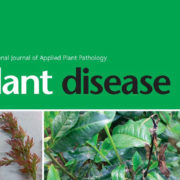First Report of ‘Candidatus Liberibacter solanacearum’ on Carrot in Greece
PLANT DISEASE October 2017, Volume 101, Number 10, Page 1819 doi.org/10.1094/PDIS-03-17-0419-PDN
ABSTRACT
In July 2016, a sample of 3-month-old carrot (Daucus carota L.) plants var. Dordogne from the region of Neochoraki (Boeotia, central Greece) exhibiting symptoms of secondary taproots, was sent for examination to the Benaki Phytopathological Institute (BPI). According to the sample information sheet, 35 to 40% of plants of a 10-ha commercial field were symptomatic; in the preceding years, this percentage was about 5 to 10%. The symptoms resembled those of carrots infected by ‘Candidatus Liberibacter solanacearum’ (CaLsol), Spiroplasma citri, or phytoplasmas (Munyaneza et al. 2015; Tahzima et al. 2014). In the same month, asymptomatic carrot plants were collected by the authors in a region ∼80 km from Neochoraki, to be used as negative control in the diagnosis. Total DNA was extracted from leaves and root tissues of two symptomatic and two asymptomatic carrot plants, individually, using a cetyltrimethylammonium bromide (CTAB) buffer extraction method. The DNA extracts were tested by PCR using primer pairs for: (i) CaLsol, i.e., OA2/OI2c, LsoTX16-23F/LsoTX16-23R, CL514F/CL514R, and OMB1482F/OMB2086R amplifying, respectively, fragments of 16S rDNA gene, 16-23S rRNA intergenic region, rpIJ/rpIL 50S rDNA ribosomal protein genes, and the outer membrane protein (OMP) gene; (ii) Spiroplasma citri, i.e., p89F/p89R and RFP3/RFM3; (iii) phytoplasmas, i.e., P1/P7 followed by R16F2n/R16R2 (Alfaro-Fernández et al. 2015; Lee et al. 2006; Munyaneza et al. 2015; Tahzima et al. 2014; Teresani et al. 2014). S. citri and phytoplasmas were not detected in any of the DNA extracts. CaLsol was detected with all four primer pairs in leaves and roots of the two symptomatic plants, but not of the two asymptomatic ones. CaLsol was similarly detected in archived DNA from leaves of three carrot plants, variety Newhall, exhibiting yellowish and purple leaf discolorations and stunting shoots, sent to BPI in September 2014 from an area ∼18 km from Neochoraki. One of them had been then found infected by a phytoplasma. The PCR amplicons with the four primer pairs for CaLsol on the DNA of two plants collected one in 2016 and one in 2014 were sequenced directly (VBC-Biotech Service GmbH, Austria) and found identical in respective regions. BLAST analysis of the obtained sequences of 16S rDNA (KY595985, KY595984) and 16-23S rRNA intergenic regions (KY595983, KY595982) showed 99% identity with the reference isolate (EU834130). The obtained rpIJ/rpIL sequences (KY595981, KY595980) were 100% identical to that of CaLsol-haplotype D from carrot in Spain (HQ454305) and the OMP sequences (KY595979, KY595978) were 98% identical to that of CaLsol from carrots in Germany (KP760078). Further sequence analysis (Teresani et al. 2014) indicated that the CaLsol strains identified so far in Greece belong to haplotype D (M.C. Holeva, unpublished data). CaLsol causes significant crop losses (Munyaneza et al. 2015; Tahzima et al. 2014) in the Mediterranean region, including North Africa and Israel (https://gd.eppo.int/taxon/LIBEPS/distribution); its first record in Greece indicates a spread in eastern Europe of an emerging pathogen threat and makes imperative the application of control measures against it.
Published on October, 2017 by PLANT DISEASE.








